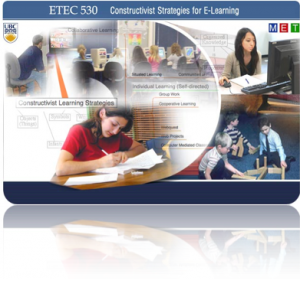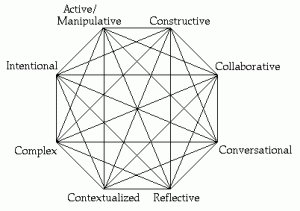ETEC 530
 ETEC 530
ETEC 530
Constructivist
Strategies for
E-Learning
“Tell me and I forget,
Teach me and I remember
Involve me and I learn.”
Benjamin Franklin
”In this course, students learn about constructivist teaching strategies for online learning as well as face-to-face learning. Assignments are geared toward students incorporating constructivist principles into the development of learning materials for online use.” UBC, MET Program.
Taking ETEC 530 helped me understand all the epistemologies of constructivism. At first I was overwhelmed by the many faces of constructivism. There is a plethora of constructivist variants. Creating a concept map helped to organize categories and subcategories to explain and link theories. One article that assisted me in my growing knowledge of constructivism was by Michael R.Matthews, 1998, Constructivism in Science and Mathematics Education.
I learned what Len Vygotsky’s constructivism meant and how theory informs practice. “For Vygotsky, the connection between the collective and the individual consciousness exists through the collective subjectivity, which is produced historically by joint-collective enactment” Liu & Matthews (2005). In other words, learning involves the social and historical assimilation of culture practices and beliefs through collective participation and collaboration.
So, what are Constructivist Learning Environments (CLE)? “Modern constructivist learning environments are technology-based in which learners are engaged in meaningful interactions. If educators are to adopt a constructivist approach, they are now met with the challenge of changing instructional design strategies.These need to engage learners in meaningful projects and activities that promote exploration, experimentation, construction, collaboration, inquiry, and reflection;” Constructivist Learning Environments (CLE).
According to Brindley, Walti, and Blaschike (2009), ” Quality learning environments include opportunities for students to engage in interactive and collaborative activities with their peers; such environments have been shown to contribute to better learning outcomes, including development of higher order thinking skills.” Specific pedagogical benefits of collaborative learning include the following:
- Development of critical thinking skills
- Co-creation of knowledge and meaning
- Reflection
- Transformative learning (Palloff & Pratt, 2005) cited by Brindley et al.
So, how do we know if students are engaging in meaningful learning? “Davis Jonassen suggests that any technology must allow students to be engaged in meaningful learning.” The following diagram is a guideline to be used when designing a Constructivist Learning Environment.
 “We learn by example and by direct experience because there are real limits to the adequacy of verbal instruction.” – Malcome Oladwell
“We learn by example and by direct experience because there are real limits to the adequacy of verbal instruction.” – Malcome Oladwell
References
Brindley, J. E., Walti, C., Blaschke, L.M. (2009). Creating Effective Collaborative Learning Groups in an Online Environment, The International Review of Research in Open and Distance Learning, Vol.10, No.3 (June-2009).
Gunn, H. Constructivist Learning Environments (CLE). http://www.accesswave.ca/~hgunn/special/papers/hypertxt/cle.html.Retrieved March 17, 2012
Liu, C.H. & Matthews, R. (2005). Vygotsky’s philosophy: COnstructivism and its criticisms examined. International Education Journal, 2005, 6(3), 386-399. ISSN 1443-1475@2005 Shannon Research Press. Retrieved February 24, 2012.
Matthews, M.R. Ed.(1998), Constructivism and Science Education: A Philosophical Examination, Kluwer Academic Publishers, Dordrecht. Retrieved on Jan.13, 2012. http://wwwcsi.unian.it/educa/inglese/matthews.html.
Retrieved on Jan.13, (2012)http://wwwcsi.unian.it/educa/inglese/matthews.html.
Click on the image below to return to the MET journey page.
